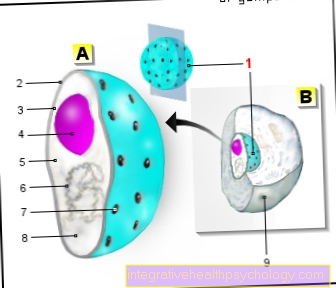stutter
Synonyms in a broader sense
Medical / technical term: Balbuties
English: Stuttering
definition
Stuttering (balbuties) describes a disturbance in the flow of speech. The speaking process is often interrupted by repetitions of sounds and word syllables. A coordination disorder of the speech muscles dominates.

Causes of stuttering
The causes of stuttering are still not fully understood. One assumes a multifactorial event. Speaking is a complex set of actions that are controlled by our brain. When speaking, breathing, vocalization and articulation must work immediately.
This interaction is disturbed when stuttering. Since stuttering also occurs more often in families, scientists assume a hereditary predisposition to stuttering. Several factors are likely to be responsible for the development and perpetuation of stuttering. Certain factors cause the speech disorder to eventually solidify.
There are both indications of a disturbance of the nerve signals in the speaking process and indications that indicate a motor disturbance in speaking. In addition, there are many cases where the cause of stuttering is trauma. Stuttering can occur post-traumatically, for example after a very serious life event. In addition, fear and nervousness can lead to stuttering or contribute to the stuttering being maintained and solidifying as a language disorder.
Mental causes
Psychological causes play an important role in the multifactorial genesis of this speech disorder. Emotions such as fear, anxiety, and nervousness can cause situational stuttering. Basically, it can happen that every person begins to stutter in uncomfortable, nervous situations.
The problem with stuttering is that psychological causes initially intensify the stuttering and can even harden over time. If there is perhaps a genetic predisposition and other factors that favor stuttering, psychological sensations can permanently anchor the speech disorder. In addition, stuttering can also result from serious trauma.
Through stress
Various factors influence the development of stuttering. Stress is an important factor that can encourage stuttering. Stress means different things to everyone and the response to stress is difficult to control. Stressful situations can trigger emotions such as fear of failure, a feeling of pressure and / or nervousness in people.
These can cause stuttering both in situations and as a long-term speech disorder. Stress has a huge impact on our health and can be a factor in causing stuttering.
Frequency - occurrence in the population
Stuttering affects boys more than girls. The ratio is 4: 1.
Psychological causes can be proven in 70 percent of stutterers.
In less than ten percent of the cases examined, a hereditary cause could be proven. Brain examinations of stuttering children have very often discovered organic brain causes. In one study, brain damage was even found in one in five.
You might also be interested in: Language disorder in children
Forms of stuttering
There are two different forms of stuttering, but they do not necessarily occur separately but can occur together.
- Tonic stutter
In tonic stuttering, syllable ends are stretched. The stuttering person is stuck in the middle of a word ("Bahn-n-nhof")
- Clonic stutter
In clonic stuttering, the first letters of the words are repeated. The person concerned creates the beginning of a word or a sentence only by repeating the beginning several times ("B-B-B-Bahnhof")
After a stroke
If stuttering occurs as a result of a stroke, although you never stuttered before the attack, scientists assume the so-called acquired neurogenic stuttering out. Stuttering rarely occurs in adulthood and when it does, the underlying cause is often serious, such as brain damage, trauma, or the influence of certain drugs (psychotropic drugs).
The brain damage caused by the stroke can result in motor disorders when speaking, which cause stuttering, or the destruction of complicated interconnections in the nervous system.
Accompanying symptoms of stuttering
The person concerned is fully aware of his or her inhibition of speech during the stuttering.
There is no arbitrary control over the flow of speech. This discrepancy creates a feeling of tension and discomfort with the environment. Especially in stressful situations or in emotions (mood), the symptoms of stuttering are even more obvious and the speech inhibition more pronounced.
The body is therefore tense or cramped from the start in the stuttering person. This is especially visible in the facial muscles. In the middle of the word or at the beginning of the word, the facial muscles can become tense. The flow of breath also comes to a standstill and is disturbed by heavy inhalation or even holding one's breath while speaking.
Tension, cramping, respiratory problems, and speech inhibition can also lead to an emotional reaction in the form of blushing, sweating, and feelings of shame.
Is Stuttering Hereditary?
Stuttering is common in families. There is currently no scientific evidence that stuttering is directly inherited. It is believed that a similar predisposition to stuttering is passed on within families. This hereditary component is also supported by the fact that boys and men stutter significantly more often than girls and women.
It is believed that stuttering has a multifactorial genesis. This means that if there is a hereditary predisposition and triggers occur, for example a stressful situation, stuttering is encouraged at the time. If this happens more often or if conditions are added to maintain the stuttering, the speech disorder becomes entrenched in those affected.
diagnosis
If a child is noticed stuttering, improvement should not be waited for on its own - it usually never happens!
Early therapy can stop later difficulties in speaking or, in the best case, eliminate them. A specialist doctor (for pediatrics / ear, nose and throat medicine) provides precise advice and diagnosis.
The pediatrician is the first point of contact. If necessary, he or she will arrange a referral to an ENT doctor or a speech therapist.
Some ENT doctors have the additional designation “phoniatrics and pedaudiology” and are usually familiar with the diagnosis and treatment of speech disorders and speech disorders.
Read more about the therapy of stuttering at: Speech therapy
Can you cure stuttering?
Stuttering is a speech disorder that is curable in many cases. Stuttering can be treated both in children and in advanced age. Stuttering therapy helps many affected people to significantly improve their way of speaking. An important aspect in the treatment of stuttering is the psyche.
You can positively influence your speech fear through stuttering if you work on avoidance behavior and speech fear. A positive self-esteem and a healthy handling of stress have a positive effect on the speech disorder.
What is the therapy for stuttering?
Since stuttering is extremely difficult to treat, especially in adulthood, it should be pointed out right at the beginning that there are many dubious healers and methods that offer a promising therapy at unspeakable prices.
However, scientifically based therapies still exist and are usually supported by health insurance.
Speech therapists, psychologists, child adolescent psychiatrists and phoniatrists (focus on ear, nose and throat doctors) have been thinking about the treatment of stuttering for decades and have developed the following approaches:
Breathing training
The patient's respiratory flow in particular is significantly disturbed. Holding your breath, exhaling heavily, unrestrained breaths make it difficult to flow. Exercises for rhythmic, relaxed breathing with simultaneous speaking exercises can lead to a more relaxed situation and better speech control.
Speech and vocal technique approach
Interestingly, the stuttering does not occur when singing. This fact can be used therapeutically.Using singing, breathing and vocal techniques, this therapy focuses on learning to speak more fluently.
Mental training
In this context, regular speaking and reading exercises attempt to first remove the fear and inhibition of speaking. Regularity and self-confidence are the pillars of this therapy. This is based on the assumption that old language patterns are superimposed through the learning of new speaking behavior.
Modification Approach
Behavioral therapeutic methods are intended to make it easier for those affected to accept their speech disorder. Using situation and communication training within a group, fear and speech inhibition should be removed. The aim is to modify stuttering - that is, to improve stuttering symptoms - and not to cure it completely.
Other methods
The following methods are partly used in a supportive manner and in combination with the other approaches. A therapy is individually tailored for each stutterer and always takes age, symptoms, requirements, intelligence, etc. into account.
Methods from the following areas are also used:
- hypnosis
- Autogenic training
- yoga
- Muscle relaxation
- Play therapy, conflict resolution in the context of early intervention
- Behavior therapy
- Depth psychology
What does stuttering therapy in children look like?
Not every child who stutters needs therapy. There is a high spontaneous healing rate in children who stutter, especially in young children. However, if a child becomes psychologically abnormal or develops behavioral patterns in order to avoid speaking, stuttering therapy should be considered. Stuttering therapy often takes place in the form of intensive therapy.
This includes speech therapy that takes place once a week. Methods such as respiratory therapy, psychotherapy or hypnosis are also used. It is important that the therapy is individually tailored to the needs of the child concerned. Serious stuttering therapy should have the following content:
-
Intensive learning and consolidation of the new stutter-free speech pattern
-
An intensive, clearly structured aftercare phase
-
An accompanied transfer of what has been learned in everyday life
-
A constant success control
Depending on the age of the child, stuttering therapy is carried out in children according to their age. In group sessions, there are often joint exercise, speaking and play rounds in a group. In addition, it is essential for the success of the therapy that the parents are trained and actively support the children in stuttering therapy.
What does stuttering therapy look like in adults?
Stuttering therapy looks a little different in adults than in children. Speech therapy, breathing therapy, psychotherapy and hypnosis or body coordination are the basis of stuttering therapy. Since adults are mostly involved in everyday work and / or family life, there are offers for intensive therapies over two weeks or therapies that take place once a week for months.
Adults do exercises such as speaking exercises on the computer or joint reflection in group sessions. Similar to children, stuttering therapies for adults often take place in group sessions in which people practice and talk together. Typical exercises for adults are, for example, speaking training in the form of lectures and reading and telephone exercises.
Situations are practiced that are typical in an adult's everyday life. For example, those affected should practice addressing passers-by or having a sales pitch in a shop. Adults are solely responsible for follow-up care after stuttering therapy. Often those affected are given Internet programs and refresher courses to take at home to use in a structured way for practicing. The aftercare of stuttering therapy serves to consolidate the more fluent way of speaking.
Speech therapy
Speech therapists are experts in speech, speech and voice disorders. You are able to find out whether the person affected actually has a speech disorder and to treat it on the basis of a doctor's prescription. Disturbances of speech understanding, spoken and written language, speaking, breathing, voice, but also mouth function, hearing and even swallowing are examined.
Speech therapy is individually tailored to the needs and age of the person affected and is either direct or indirect. Indirectly means that the speech therapy works with the child in a playful way without directly addressing the speech disorder. Here the children learn new words or sounds, which they transfer to everyday life without thinking about them.
You learn words in a playful way and apply them “in real life”. With a direct approach in therapy, the child knows exactly why it is being treated. This also enables the children to practice tasks at home independently, which means that progress can be seen quickly. In adults, stuttering therapy is also used directly.
Medication
There are not yet any drugs against stuttering itself. However, drugs against states of tension and anxiety (anxiety) can alleviate certain situations and thereby improve the symptoms.
Child and youth psychiatrists can give the best advice on this. You have a wealth of experience in anxiety therapy and know the spectrum of anti-anxiety drugs (anxiolytics).
- When does the stutterer feel relief?
- What should accompany every therapy?
- What can parents and teachers do?
If the caregivers listen to the stutterer patiently, let him finish speaking and approach them with understanding, this usually leads to the stutterer enjoying speaking and making it easier for him to control his own flow of speech.
Stuttering should not be considered in the family. On the contrary, corrective interventions by others, impatience and unacceptance promote a stressful situation and make it difficult for the person concerned to speak.
The latter mainly takes place in school. Children quickly recognize that they can weaken and offend their stuttering classmate, are happy to correct them and annoy them with smiles and ignorance. Parents and teachers should therefore not be afraid to openly address the situation in the class in order to appeal to the understanding of their classmates!
The person concerned usually does not like to talk about such teasing and skilfully hides his shame from the educators and parents.
Here, too, open discussions should be held every now and then in order to assess the child's situation and, if necessary, take action.
Prognosis of stuttering
About 90% of those who stutter start stuttering before the age of six. The majority of those affected lose their speech disorder by puberty. Stuttering starts earlier, especially in girls. At the same time, girls put off the speech disorder sooner on their own. The prognosis for stuttering depends on the therapy. Those affected who stutter after puberty have a small chance of speaking completely free of stuttering.
It is therefore important to consider stuttering therapy early on if serious stuttering is suspected. Improvement in stuttering can still occur at any age with or without treatment. Therapy helps most stutterers very well. Complete remission is not always possible. However, stuttering therapy helps most people to speak more comfortably. Therapy is therefore indicated for both children and adults.
Related topics
For more information, see:
- Speech disorder
A list of all topics that we have published under our "Problems with learning" page can be found under: Problems with learning A-Z





























